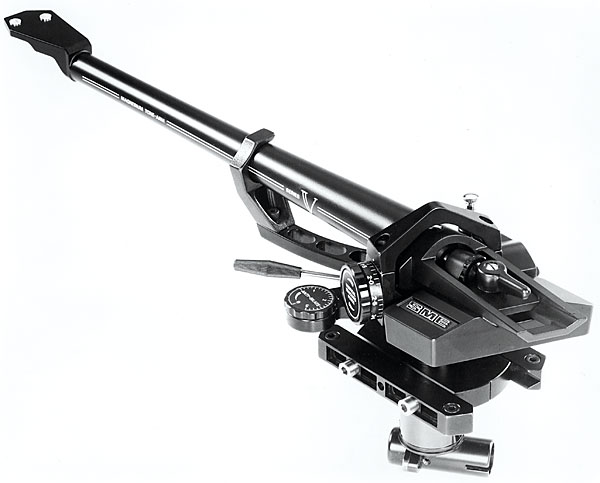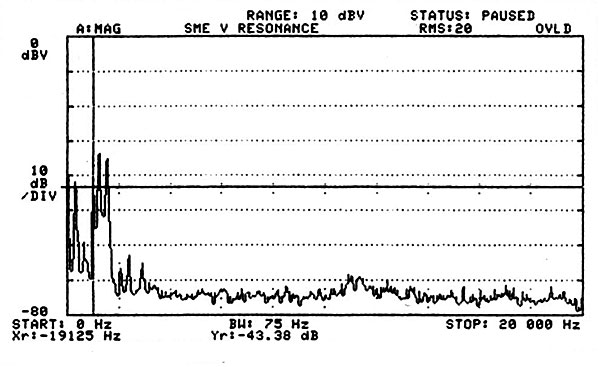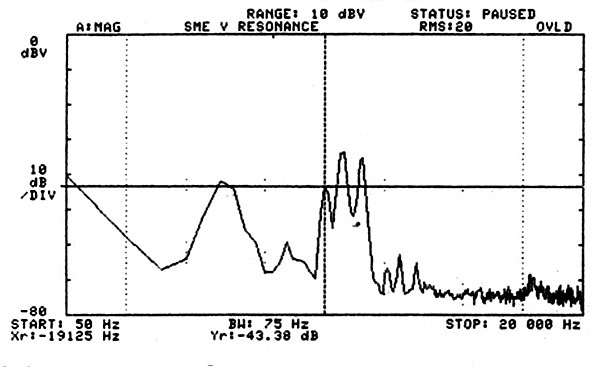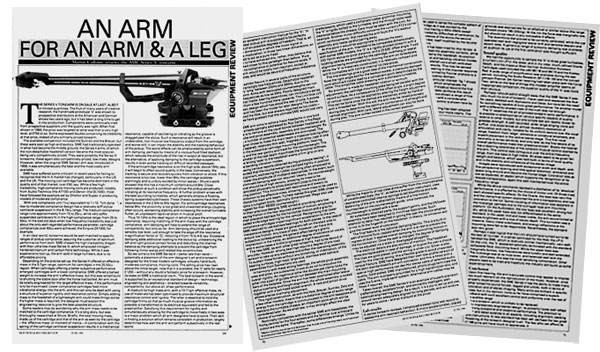The World's Best Tonearm? Page 2
Damping Facility
While the majority of top-class arms suffer from the inconvenience of uncalibrated dials, the 'V', as befits a precision instrument, uses resonance-controlled internal springs to set downforce and bias. Balancing of the arm is attained by means of a fine motion thumbscrew on the counterweight guide; once balanced, the counterweight is locked with a lever.
All subsidiary attached parts, the support gantry, and the lift/lower assembly have been designed to minimise resonances. Such attention to detail has resulted in giving the user the choice whether or not to fit the fingerlift on the headshell. In theory, its omission will give the lowest level of coloration.

The final feature is the optional damping facility. This is a built-in well of silicone fluid, capped when the arm is at rest to prevent the ingress of dust. lt applies overall damping by controlling motion in the horizontal arc. Once the well is charged, the degree of damping may be adjusted via a scale or disengaged altogether.
The electrical details are also worthy of mention. To begin with, the headshell wires are replaceable in case they should suffer damage, or to give the user a choice. Their clips are gold-plated, and the wiring is silver Litz. Silver is also used for the internal wiring and this is a flexible grade to avoid unwanted torque fracture. SME has designed its own low-profile version of the semi-standardised 5-pin arm connector, and this is fitted with a special high performance van den Hul stereo cable of selected audio quality. Gold-plated phono plugs terminate the cable and these are manufactured by SME itself. Finally, the tonearm is properly grounded for a high signal/noise ratio, and uses the 5-wire, triple earth system. Alternative arm cables may be fitted if required.
Taken overall, the SME Series V is an example of superb precision craftsmanship, excellent finish, and eminently intelligent, well-balanced engineering design. As a result, it is a joy to set up and use, should remain adequately aligned for long periods, and will endure for years to come – and so it should at the price!


We had the opportunity to sample the 'V' in three great turntables. These comprised a current Linn LP12; the latest, and in my view, much-refined Oracle Delphi; and the massive West German Audiolabor Konstant. Cartridges used included the vdH MC1B and MC10 and the Koetsu Red. A wide range of amplification was available during the test period, including the Conrad Johnson Premier 3/4 and the Audio Research SP-11/M-100. Earlier listening had taken place with the Cyrus Two. While on the face of things this modest amplifier seems an inappropriate companion, the superior quality of the SME Series V was more than obvious.
Sound Quality
Perhaps I should admit straight away that the 'V' was very much my kind of tonearm. I have used and respected the lttok for years, dabbled with designs from Alphason and Zeta, but have felt the need for something capable of truly great performance. Yet another model with a differently shaded view of the truth was not enough.
The 'V' redefines the art of pivoted tonearm sonic performance. lt is possible to extemporise on various specific aspects of quality relative to other models, but one simple test will readily reveal its greatest strength, and this is a well-recorded, wide-range singing voice. Here one experiences an almost revelatory exposition of articulation and clarity, notable for its uniform texture over the vocal range, freedom from 'edge', sibilance or unnatural emphasis, and superb placement in the stereo stage.
This fine vocal neutrality is the arm's key attribute, and only later do the fine details of its overall performance make their presence known. Slowly the listener has a dawning awareness of the coherent musical control exerted by this arm. This control was contiguous over the entire frequency range, from low bass to high treble. All areas seem to be given fair weight and balance, which was held both in terms of tonal quality and in the stability and coherence of the stereo image.
Images were reproduced with exceptional width and depth, with fine perspective layering and little spatial distortion, ambience and space lying around and beyond the frontal stage. Coloration was as low as expected, an aspect which supports the recognition of its relaxed transparency, again this being well maintained over the entire frequency range.
Match Point
While the above comments represent a distillation of the arm's 'absolute' performance, it is affected by the choice of motor unit, and of those tried, each showed specific effects. On the Oracle Delphi, the bass was very fine and the clamp/mat system exploited the arm's transparency and low coloration to the full. Some clouding of information was apparent in the midrange, perhaps due to the outrigger type arm mounting platform.

However, on the Audiolabor Konstant, the low bass was excellent, strong but dry, while the upper bass was not differentiated to the same standard. In the upper mid and lower treble, the arm sound hinted at excess brightness with a loss of stereo depth. This turntable uses a massive, heavy metal subchassis, and energy reflections at the mounting were felt to be responsible. Nevertheless, the standard was very good.
Perhaps it was logical that the Linn should have turned out to be the best all-rounder. In a sense optimised for the lttok, the LP12 handled the 'V', which is relatively similar mechanically, very well.
On the LP12, the 'V' appeared optimally terminated with the standard, composite fibre mounting board. While the upper bass was marginally bumpy, low frequencies were tuneful and well-extended. The midrange was at its most even, and balanced well with the treble. Ultimately, this was the most satisfying combination. Other players need to be tried, and hopefully the industry will build up some experience here.
Conclusion
Upon first hearing, the arm's accurate control may appear to impose too much restraint on the reproduction of the music. However, once properly experienced, the SME Series V has the ability to make many other tonearms sound forced, ragged and untidy, both in terms of coloration and of stereo imaging. Many arms are brilliant in specific areas, but in my opinion, none so far has comprised a superb midband with such excellent control and uniformity over the rest of the audible range. This is a tonearm that is unlikely to be replaced.
As a company, SME has certainly suffered some criticism over recent years for failing to recognise that the quality end of the hi-fi market has changed, particularly in the US and the UK, where the moving-coil cartridge is now dominant. But the Series V tonearm is an impressively engineered design, its powerful looks reflecting its remarkably strong performance. What's more, the attention to finish and detail extends to all aspects, including alignment, packing and instructions. A new standard has been set, perhaps the last great flowering of the tonearm designer's art. The few who can afford its £1188 price will have much to appreciate.


















































